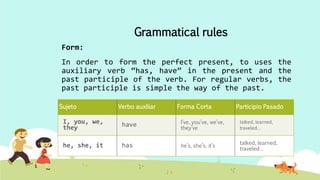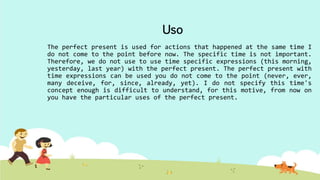El documento explica el presente perfecto en inglés, incluyendo su forma, uso y ejemplos. Se detalla cómo se forman oraciones afirmativas, negativas e interrogativas, así como los contextos en los que se utiliza este tiempo verbal. Se enfatizan experiencias, cambios y acciones mantenidas en el presente como los principales objetivos de su uso.




![Estructure
Affirmative Sentences
Sujeto + verbo auxiliar (has, have) + Verbo en participio pasado + Complemento
Ejemplos:
I have [I’ve] talked to Peter. (He hablado con Peter.)
She has [She’s] gone to work. (Ha ido a su trabajo.)
We have [We’ve] been to London. (Hemos ido a Londres.)
They have [They’ve] learned English. (Han aprendido inglés.)](https://image.slidesharecdn.com/present-perfect-151010011150-lva1-app6892/85/Present-perfect-5-320.jpg)









